*NURSING > QUESTIONS & ANSWERS > Nclex questions...good...Hematology Nursing III sickle cell anemia, anemia, thrombocytopenia, IVS, A (All)
Nclex questions...good...Hematology Nursing III sickle cell anemia, anemia, thrombocytopenia, IVS, All Questions and answers, Graded A+, 2022/2023
Document Content and Description Below
Nclex questions...good...Hematology Nursing III sickle cell anemia, anemia, thrombocytopenia, IVS, All Questions and answers, Graded A+, 2022/2023 A child is suspected of having sickle cell disea... se is seen in a clinic, and laboratory studies are performed. A nurse checks the laboratory results, knowing that which of the following would be increased in this disease? 1. platelet count 2. hematocrit level 3. reticulocyte count 4. Hemoglobin level - ✔✔answer: 3 Rationale: A diagnosis is established based on a complete blood count, examination for sickled red blood cells in the peripheral smear, and hemoglobin electrophoresis. Laboratory studies will show decreased hemoglobin and hematocrit levels and a decreased platelet count, an INCREASED reticulocyte count and the presence of nucleated red blood cells. Increased reticulocyte counts occur in children with sickle cell disease because the life span of their sickled red blood cells is shortened. A pediatric nursing instructor asks a nursing student to describe the cause of the clinical manifestations that occur in sickle cell disease. The student responds correctly by telling the instructor that 1. Sickled cells increase the blood flow through the body and cause a great deal of pain. 2. sickled cells mix with the unsickled cells and cause the immune system to become depressed. 3. bone marrow depression occurs because of the development of sickled cells. 4. sickled cells are unable to flow easily through the microvasculature and their clumping obstructs blood flow. - ✔✔Answer: 4 Rationale: all of the clinical manifestations of sickle cell disease result from the sickled cells being unable to flow easily through the microvasculature, and their clumping obstructs blood flow. With re-oxygenation, most of the sickled red blood cells resume their normal shape. Options 1, 2, and 3 are incorrect statements. A clinic nurse instructs the mother of a child with sickle cell disease about the precipitating factors related to pain crisis. Which of the following, if identified by the mother as e precipitating factor, indicates the need for further instructions? 1. infection 2. trauma 3. fluid overload 4. stress - ✔✔answer: 3 Pain crisis may be precipitated by infection, dehydration, hypoxia, trauma, or physical or emotional stress. THe mother of a child with sickle cell disease should encourage fluid intake of 1.5-2 times the daily requirement to prevent dehydration! Laboratory studies are performed for a child suspected of having iron deficiency anemia. THe nurse reviews the laboratory results, knowing that which of the following results would indicate this type of anemia? 1. An elevated hemoglobin level 2. a decreased reticulocyte count 3. an elevated rbc count 4. rbc that are microcytic and hypochromic - ✔✔Answer: 4 The results of a cbc in children with iron deficiency anemia will show a decreased hemoglobin level and and microcytic and hypochromic rbc the rbc count is decreased, the reticulocyte count is usually normal or elevated. A home care nurse is instructing the parents of a child with iron deciciency anemia regarding the administration of a liquid oral iron supplement. The nurse tells the mother to 1. administer the iron through a straw 2. administer iron at meal times 3. add the iron to the formula for easy administration 4. mix the iron with cereal to administer - ✔✔answer: 1 Iron should be administered through the straw or with a medicine dropper placed at the back of the mouth because the iron will stain the teeth. the parent should be instructed to brush or wipe the teeth after administration. Iron is administered between meals because absorption is decreased if there is food in the stomach. Iron requires an acid environment to facilitate its absorption in duodenum. Iron is not added to formula or mixed with cereal or other food items. A client with anemia has a nursing diagnosis of activity intolerance. Which of the following interventions will the nurse plan for this client? 1.Promote active and passive range-of-motion activities. 2.Space activities and plan rest periods. 3.Teach the client to change position slowly to prevent dizziness. 4. Teach the client the basics of good nutrition. - ✔✔answer: Space activities and plan rest periods. Rationale: The client with activity intolerance tires easily, so it is best for the nurse to plan care and activities around periods of rest. Teaching good nutrition will not help the client to be less tired. Promoting range of motion does not address the issue of fatigue, nor does teaching the client to change position slowly. The nurse notes that the client has a low red blood cell count and anticipates which of the following subjective manifestations on assessment? 1.Chest pain 2.Nausea 3.Sore throat 4. Fatigue - ✔✔Answer:Fatigue Rationale: Fatigue would signify that the body's tissues are not receiving enough oxygenation. Sore throat is a sign of infection. Chest pain may indicate an impending myocardial infarction. Nausea is a symptom for many disease processes, but is not typical for anemia. The nurse is reviewing laboratory findings for a 2-year-old being treated for anemia. Which of the findings is the best indication that goals for this client have been met? 1.The child is no longer cyanotic. 2.The reticulocyte count is rising. 3.The child is more active. 4.Stools are black, indicating iron intake. - ✔✔Answer: The reticulocyte count is rising. Rationale: An increase in the reticulocyte number means that the body is producing new RBC's. While improved oxygenation, increased activity, and indications of iron intake are desirable outcomes for the child with anemia, they are not laboratory data. The nurse has admitted a child newly diagnosed with anemia of unknown origin. Which of the following is a priority intervention for the nurse to initiate? 1. Administer fluids to increase cardiac output. 2. Plan for safe care due to weakness. 3.Teach the client about foods with iron. 4. Assess pain level. - ✔✔Answer:Plan for safe care due to weakness. Rationale: The client with anemia is weak and the nurse would address safe care due to weakness. Since the cause of the anemia is undetermined, the nurse would not administer fluids or complete nutritional teaching without additional information. Clients with anemia do not normally have pain; pain is assessed in every client, but is not the priority of care in this client. The nurse following a client after a gastric resection observes carefully for evidence of nutritional deficiency anemia related to malabsorption including which of the following? 1.Bone pain 2.Dark yellow or bronze skin 3.Numbness and tingling of extremities 4. Steatorrhea - ✔✔Correct Answer: Numbness and tingling of extremities Rationale: The client who has had a gastric resection is at risk for anemia because intrinsic factor may decrease, leading to vitamin B12 deficiency anemia with associated neurologic deficits such as numbness and tingling of extremities. The other symptoms are not related to nutritional deficiency anemia. The nurse is caring for a 78-year-old client with active alcoholism who has a vitamin B12 deficiency. The nurse plans to teach the client to select which of the following food choices? (Select all that apply) 1.Apples 2.Carrots 3.Liver 4.Oranges 5.Spinach - ✔✔answers: Oranges Spinach Liver Rationale: Clients with vitamin B12 deficiency would be encouraged to eat spinach, oranges, and liver as good sources of the vitamin. Apples and carrots are not good sources for vitamin B12. A client with iron deficiency anemia has been placed on an iron supplement. Which of the following would the nurse include in the teaching plan about this form of therapy? 1.Iron may cause the stools to be tarry. 2.Iron should be taken in the afternoon. 3.Iron can cause severe headaches. 4.Iron can cause the urine to be orange. - ✔✔Your Answer:Iron may cause the stools to be tarry. Rationale: The client is taught that stools may be black and tarry while taking iron. Orange urine and headaches are not associated with taking iron. Iron should be taken with food to reduce gastric distress. The nurse is working with a woman who is pregnant and her husband. The husband asks the nurse why his wife has a folic acid deficiency when she eats healthy meals. The nurse best responds with which of the following? 1.Pregnancy increases metabolic requirements for folic acid. 2.There is inadequate dietary intake of folic acid. 3.Pregnancy causes malabsorption of folic acid. 4.The client has some form of impaired metabolism - ✔✔Answer:Pregnancy increases metabolic requirements for folic acid. Rationale: Pregnancy increases the metabolic requirements for folic acid. Since the husband states that they eat healthy meals, inadequate intake of folic acid is a less likely cause of the deficiency. Malabsorption and impaired metabolism are causes of folic acid deficiency that are not associated with pregnancy. The nurse is teaching a group of parents whose children have sickle cell anemia. When a parent asks the cause of the symptoms, the nurse responds with which of the following? 1."Sickled cells clump in the smaller blood vessels and obstruct blood flow." 2."Sickled cells cause bone marrow depression." 3."The sickled cells mix with normal cells, which causes the immune system to be depressed." 4."Sickled cells increase the blood flow through the body, which causes pain." - ✔✔Your Answer: "Sickled cells clump in the smaller blood vessels and obstruct blood flow." Rationale: All the symptoms of sickle cell are a result of the clumping of the sickled cells in the microvasculature, causing obstruction of blood flow. The other statements are inaccurate. A child with suspected sickle cell disease (SCD) is in the clinic for laboratory studies. The parents ask the nurse what results will tell the physician that their child has SCD. The nurse responds that which of the following is increased in this disease? 1.Reticulocyte count 2.Hematocrit 3.Hemoglobin 4.Platelet count - ✔✔Answer: Reticulocyte count Rationale: The reticulocyte count will be increased because the life span of sickled red blood cells is shortened. Hemoglobin, hematocrit, and platelet levels will be decreased. The nurse is instructing the mother of a child with sickle cell disease about the risk factors for precipitation of sickle cell crisis. Which of the following, if identified by the mother as a precipitating factor, indicates the need for further teaching? 1.Stress 2.Trauma 3.Fluid overload 4.Infection - ✔✔Answer: Fluid overload Rationale: Sickle cell crisis may be precipitated by dehydration, not fluid overload. Infection, trauma, and stress are all factors that may cause sickle cell crisis. A pregnant woman tells the nurse that there is a history of sickle cell disease in her family and she is afraid that the baby will have the disease. The nurse provides the client with which of the following information? 1.Sickle cell is a male disease and would be passed on by the baby's father. 2.The baby needs only one parent to be a carrier to be affected. 3.Both the mother and father must carry the gene for the baby to be affected. 4.Genetic testing will be needed to determine if the baby is affected. - ✔✔Answer: Both the mother and father must carry the gene for the baby to be affected. Rationale: Sickle cell is inherited as an autosomal recessive disorder. Both parents must carry the gene for the baby to be affected. The other statements are inaccurate. The nurse is caring for a child who is in the hospital experiencing sickle cell crisis. The parents are asking the nurse which treatment will help cure the child. The nurse responds with which of the following? 1. Treatment with an exchange transfusion of blood will cure the child. 2. Treatment with morphine will cure sickle cell disease. 3. There is no treatment for sickle cell crisis. 4. Treatment is aimed at pain control, oxygen therapy, and hydration, but does not provide a cure. - ✔✔Answer: Treatment is aimed at pain control, oxygen therapy, and hydration, but does not provide a cure. Rationale: Treatment for sickle cell crisis is pain control, oxygenation, and fluid resuscitation. There is no cure for sickle cell disease. The nurse teaches families how to prevent sickle cell crisis. The nurse is admitting a 7-year-old client who is experiencing sickle cell crisis and plans care based on which of the following nursing diagnoses? 1. Risk for Bleeding 2. Ineffective Airway Clearance 3.Risk for Constipation 4. Delayed Growth and Development - ✔✔answer: Delayed Growth and Development Rationale: The child with sickle cell disease is often developmentally delayed due to the effects of physical disability, pain, and inpatient hospital stays. The nurse would plan activities that help maintain developmental levels the child has reached. The child in sickle cell crisis does not experience ineffective airway clearance, bleeding, or constipation as a result of sickle cell disease. The child may have an illness that could cause one of these symptoms, but they are not common to children with sickle cell disease. The nurse is evaluating a child in sickle cell crisis who was at risk for a cerebrovascular accident. The nurse monitors the child by evaluating which of the following? 1.Renal system 2.Neurovascular system 3.Cardiovascular system 4.Gastrointestinal system - ✔✔Correct Answer: Neurovascular system Rationale: Symptoms of a cerebral vascular accident (CVA) are best noted with an assessment of the neurovascular system. While the other systems may provide some evidence of a CVA, it is the neurovascular system that gives the best informatio The nurse is planning care for a child who is newly diagnosed with sickle cell disease. Which of the following would the nurse plan with the family to best promote the child's growth and development? 1.Renal health plan 2.Emergency care in the school setting 3.Nutritional support during hospitalizations 4. Individualized school health plan - ✔✔Answer: Individualized school health plan Rationale: Children with sickle cell disease will have sickle cell crises no matter how well the child is protected, and may miss a great deal of school. Planning ahead with the school system and parents to continue schooling during recuperation can help the child maintain developmental progress. Most schools are equipped to deal with emergencies that children have. Nutrition is important to development, but a long-range plan with the school will better promote development and learning. Renal health plan is not an appropriate answer. A nurse is planning care for a client who has a Hgb of 7.5 and a Hct of 21.5. Which of the following should the nurse include in the plan of care? select all that apply a. provide assistance with ambulation monitor oxygen saturation c. weigh client weekly d. obtain stool specimen for occult blood e. schedule daily rest periods - ✔✔a,b,d,e rationale: a client with anemia may be dizzy and should be assisted to prevent falls, o2 should be monitored due to decreased o2 carrying capacity in the blood, they should be weight dialy, stool testing is performed to id cause of anemia due to gi bleeding, a client may experience fatigue so rest period should be planned to conserve energy A nurse is teaching a client who has a new script for ferrous sulfate. Which of the following should be included in the teaching? a. stools will be dark red in color b. take with milk if gi distress occurs c. foods high in vitamin c will promote absorption d. take for 14 days - ✔✔C. Vitamin c enhances the absorption of iron by the intestinal trat, stools will be dark green to black, milk binds with iron and decreases absorption, iron therapy can take 4-6 weeks for hgb and hct to return to normal referene range A nurse is providing discharge teaching to a chilent who has a gastrectomy for stomach cancer. Which of the following information should be included in the teaching? select all that apply a. you will need a monthly injection of vitamin b12 for the rest of your life b. using nasal spray of vitamin b12 may be an option daily c. an oral supplement of vitamin b12 may be taken as an option daily d. u should increase animal proteins, legumes, dairy to increase vitamin b12 e. add soy milk with vitamin b12 to your diet to decrase risk of pernisious anemia - ✔✔answer a and b a client with gastrectomy will require monthly injections of vitamin b12 for the rest of his life, cyanocoblamin nasal spray is an option for a client with gastrectomy. the rest will not be absorbed due to lack of intrinisctfactor produced by stomach A nurse is completing an integumentary assessment of a client who has anemia. which of the following is an expected finding a. absent turgor b. sppon shaped nails c. shiny, hairless legs, d. yellow mucous membranes - ✔✔answer: b spoon shaped nails, pail nail beds and mucous membranes are all present iwithin these patients A nurse in a clinic receives a phone call form a client seeking info about his new prescription for erythropoietin (epogen) which of the following inf o should be reviewed with the client. a. the client needs an erythrocyte sedimentation rate test weekly (esr) b. the client should have his hemoglobin checked twice a week c. o2 saturation levels should be monitored d. folic acid production will increase. - ✔✔answer: hemoglobin/ hematocrit will be measured twice a week bp is monitored for an increase, erythropoietin promotes increased production of rbc, it is evaluated by changes in hematocrit During the nursing assessment of a patient with anemia, the nurse notes ad significant the patients history of... a. reurring infections b. partial gastrectomy c. corticosteroid therapy d. oral contraceptive use - ✔✔answer b the parietal ells of the stomach secrete intrinsic factor, a substance necessary for absorption of viam b 12 and if all or part of stomach is removed the lack of intrinsic factor can lead to impaired rbc production and perniscuous anemia During assessment of a patient with thrombocytopenia, the nurse would expet to find? a. sternal tenderness b. petechial and purpura c. jaundiced sclera and skin d. tender enlarged lymph nodes. - ✔✔answer: b. petachiae and purpura rationale: petechiae are small, flat, red, or red brown pinpoint microhemorrhages that occur ont eh skin when platelet levels are low and when they are numerous, they group causing reddish bruises known as purpura. jaundice occurs when anemias are of a hemolytic origin, resulting in accumulation of bile pigments from rbc, enlarged lymph nodes are associated with infection, sternal tendernesss w leukemias Match each of the anemic states with etiologic and morphologic classification systems etiologic: 1. decreased rbc production 2. blood loss 3. increased rbc destruction morphologic: 4.normocytic, normochromic 5. macrocytic, normochromic 6. microcytic, hypochromic a. acute trauma ___ _____ b. iron deficiency anemia ___ ______ c. sickle cell anemia _____ ________ - ✔✔answers: a 2,4 b. 1, 6 c 2,4 On physical assessment of the patient with severe anemia the nurse would expect to fin? a. nervousness and agitiation b. fever and tenting of the skin c. systolic murmur and tachycardia d. bluish mucous membranes and reddened - ✔✔answer: c. systolic murmors and tachycardia tachycardia occurs in severe anemia as the body compensates for hypoxemia and the low viscosity of the blood contributes to the development of systolic murmurs and bruits. depression of the cns is common with fatigue, lethargy, and malaise, poor skin turgor may be present, but fever is not associated with anemia. skin and membranes ar pale with blue tinged to sclera a nursing diagnosis that is appropriate for patients with moderate to sever anemia of any etiology is a. impaired skin integrity related to edema and pruiortos b. disturbed body image related to changes in appearance and body function c. imbalanced nutrition less than body requirements related to lack of knowledge of adequate nutrition d. activity intolerance related to decreased hemoglobin and imbalance between o2 supply and demand - ✔✔answer d: pts with anemia have decreased hemoglobin and symptoms of hypoxemia, leading to activity intolerance. impaired skin integrity and body image disturbance may be appropriate for patients with jaundice from hemolytic anemias, and altered nutrition is indicated whn iron, folic acid, or vitamin b intake is deficint Match the following terms with the correct anemia: 1. iron deficiency 2. sickle cell a. hypoxia induced change in rbc b. most common type of anemia c. may occur with removal of duodenum d. associated with vascular occlusion and tissue infarction e. associated with chronic blood loss - ✔✔answer. 1.b. c, e 2. a. d To prevent a common side effect of oral iron supplements, the nurse teaches the patient to a. take the iron preperations with meals b. increase fluid and dietary fiber intake c. report presence of black stools to physician d. use enteric coated preps taken with oj - ✔✔answer: B rationale constipation is a common side effet of oral iron supplementation. should be taken before meals, stools are expected to be blak, taking with oj enhances absorption but enteric coated are ineffective because of unpredicatable release of iron in area of gi tract where it can be absorbed Lab and diagnostic test findings would expect in an anemic pateitn with alcoholism include - ✔✔decreased serum folate and increased mchc The anemia that follows aute blood loss is morst frequently treated with increased dietary iron intake, true or false? - ✔✔false- blood transfusions or iron supplements The anemia of sickle cell disease is caused by a. intravascular hemolysis of sickled rbc b. accelerated breakdown of abnormal rbc c. autoimmune antibody destruction of rbc d. isoimmune antibody antien reactions with rbc - ✔✔answer b. a pt with sickle cell anemia asks the nurse why the sickling crisis does not stop when o2 therapy is started. the nurse explains that a. sickling occurs in response to decreased blood viscosity, which os not affected by o2 therapy b. when rbc sickle, they occlude small vessels, which cause more local hypoxia and more sickling c. destruction of abnormal cells results in fewer rbc to carry o2 d. o2 therapy does not alter shape of abnormal erythrocytes, but allows increased o2 concentration in hemoglobin - ✔✔answer b: during a crisis sickling cells clog small capillaries and resulting hemostasis promotes self perpetuating cycle of local hypoxia, deoxygenation, or more erythrocytes and more sickling. administration of o2 mau help further sickling, but additional o2 does not reach areas of local hypoxia caused by occluded vessels a nursing intervention indiated for pt during a sickle cell crisis is a.frequent ambulation b. antiembolism hose . restriction of sodium and oral fluids d. administration of large doses of continuous narcotic analgesics - ✔✔answer d True or false a. thrombotic thrombocytopenic purpura is characterized by decreased platelets, decreased rbc, and decreased agglutination function of platelets b, a classic manifestation of thrombocytopenia that the nurse would expect to find is ecchymosis c. The nurse suspects heparin induced thrombocytopenia and thrombosis syndrome when a patient receiving heparin induced thrombocytopenia nad thrombosis syndrome when a patient receiving heparin requires dereased heparin to maintain therapeutic activated thromboplastin times - ✔✔answer: a. false, there is increased agglutination function of platelets b. false, the nurse would find petachia c. false, increased heparin A patient has a platelet count of 50,000 and is diagnosied with immune thrombocytopenic purpura. the nurse would expect initial treatment to include a. splenectomy b. corticosteroids c. administration of platelets d immunosyppressive therapy - ✔✔answer b. corticosteroids They suppress phagocytic response of splenic macrophages, decreasing platelet function they also depress autoimmune antibody formation and reduce capillary fragility and bleeding time. During care for patient with thrombocytopenia, the nurse a. takes frequent temperatures to assess for fever b. maintains the patient on strict bed rest to prevent injury c. monitors patient for headaches, vertigo, or confusion d. removes oral crusting and scabs with firm friction every two hours - ✔✔answer: c Rationale: the major complication of thrombocytopenia is hemorrhage, and it may occur in any area of the body. cerebral hemorrhage may be fatal and evaluation of mental status for cns alteration to id cns bleeding is very important. fever is not a common finding in thrombocytopenia. protection from injury to prevent bleeding is an important nursing intervention, but strict bed rest is not indicated. oral care is performed very gently with minimum friction and soft swabs Following a splenetomy for treatment of immune thrombocytopenic purpura, the nurse would expect the patients lab results to reveal a. decreased rbc b. decreased wbc c. increased platelets d. increased immunoglobulin's - ✔✔answer: c. increased platelets splenectomy may be indicated for treatment of itp, and when spleen is removed platelet counts increase significantly in most patients in any of the disorders in which spleen removes excessive blood cells, splenectomy will most often increase peripheral rbc, wbc, and platelet counts While receiving a unit of packed rbc, the pt develops chills and a temp of 102.2. The nurse a. notifies physician and blood bank b. stops transfusion and removes iv catheter c. adds a leukocyte reduction filter to the blood administration set d. recognizes this as a mild allergic transfusion reaction and slows the transfusion - ✔✔answer a: chills and fever are symptoms of an acute hemolytic or transfusion reaction if these develop the transfusion should be stopped, saline infused through the iv line, the physician and blood bank notified immediately, the id tags rechecked and vital signs and urine output monitored. addition of a leukocyte reduction filter may prevent a febrile reaction but is not helpful once the reaction has occurred. mild and transient allergic reactions indicated by itching and hives might permit restarting of transfusion after treatment with antihistamines. [Show More]
Last updated: 1 year ago
Preview 1 out of 53 pages
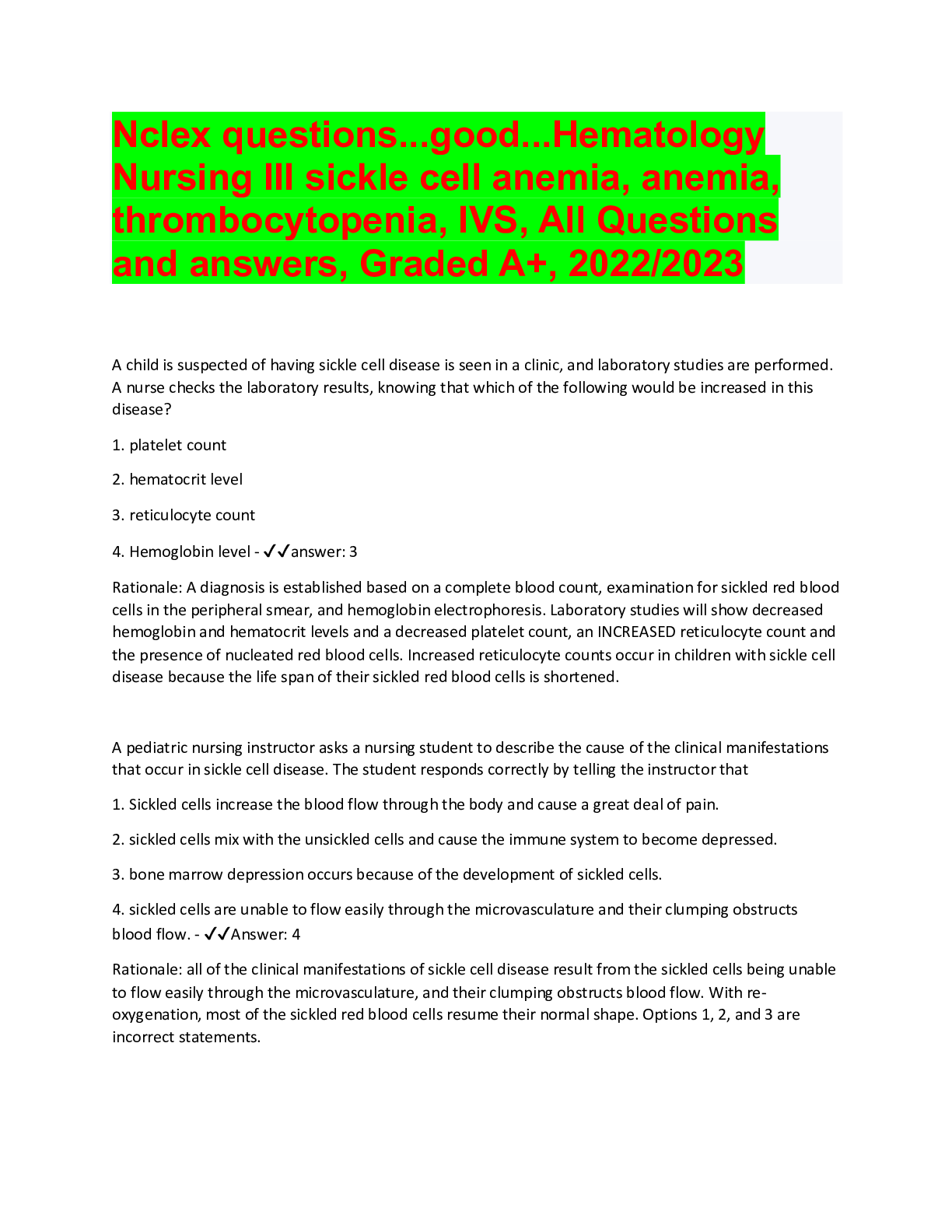
Buy this document to get the full access instantly
Instant Download Access after purchase
Add to cartInstant download
We Accept:

Reviews( 0 )
$11.00
Document information
Connected school, study & course
About the document
Uploaded On
Aug 30, 2022
Number of pages
53
Written in
Additional information
This document has been written for:
Uploaded
Aug 30, 2022
Downloads
0
Views
117












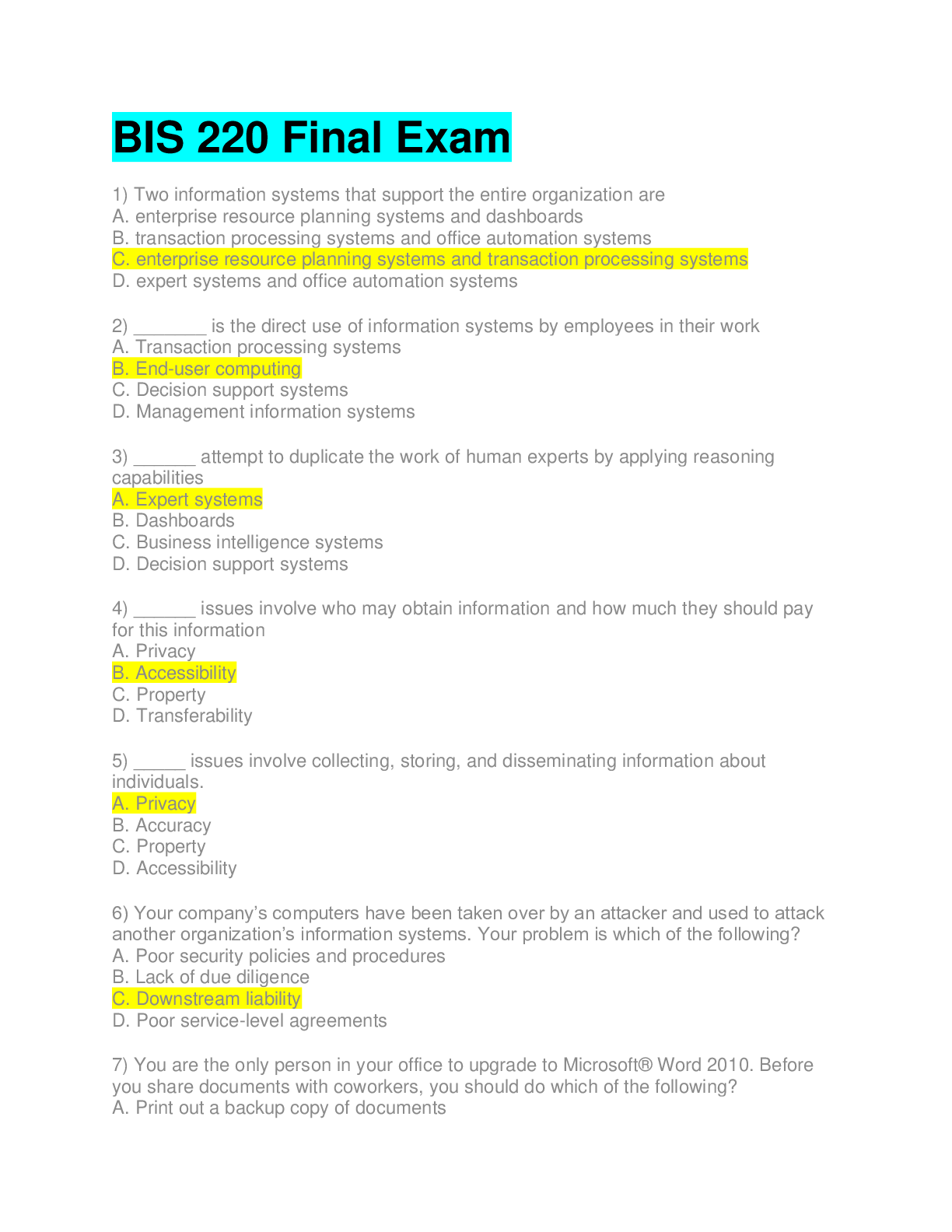

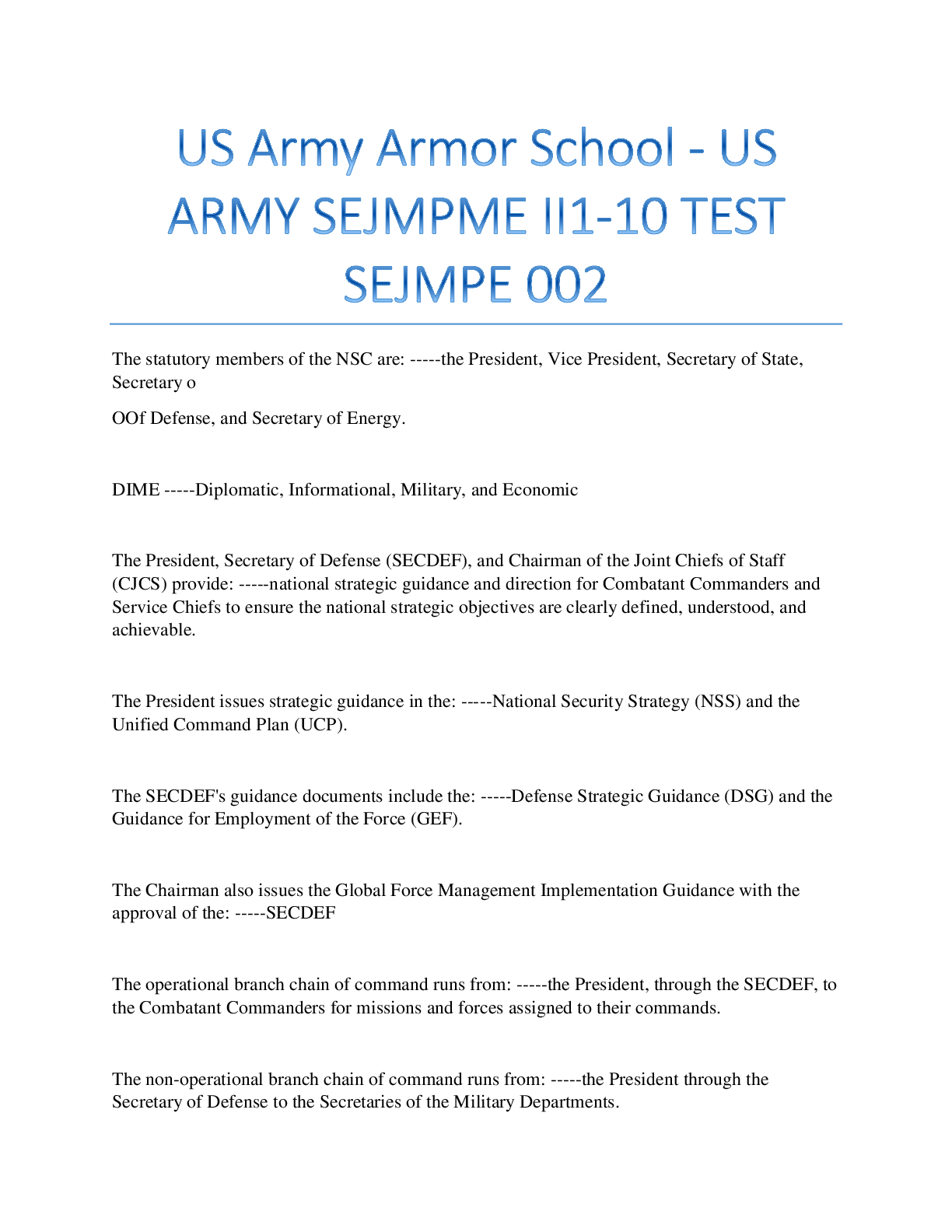



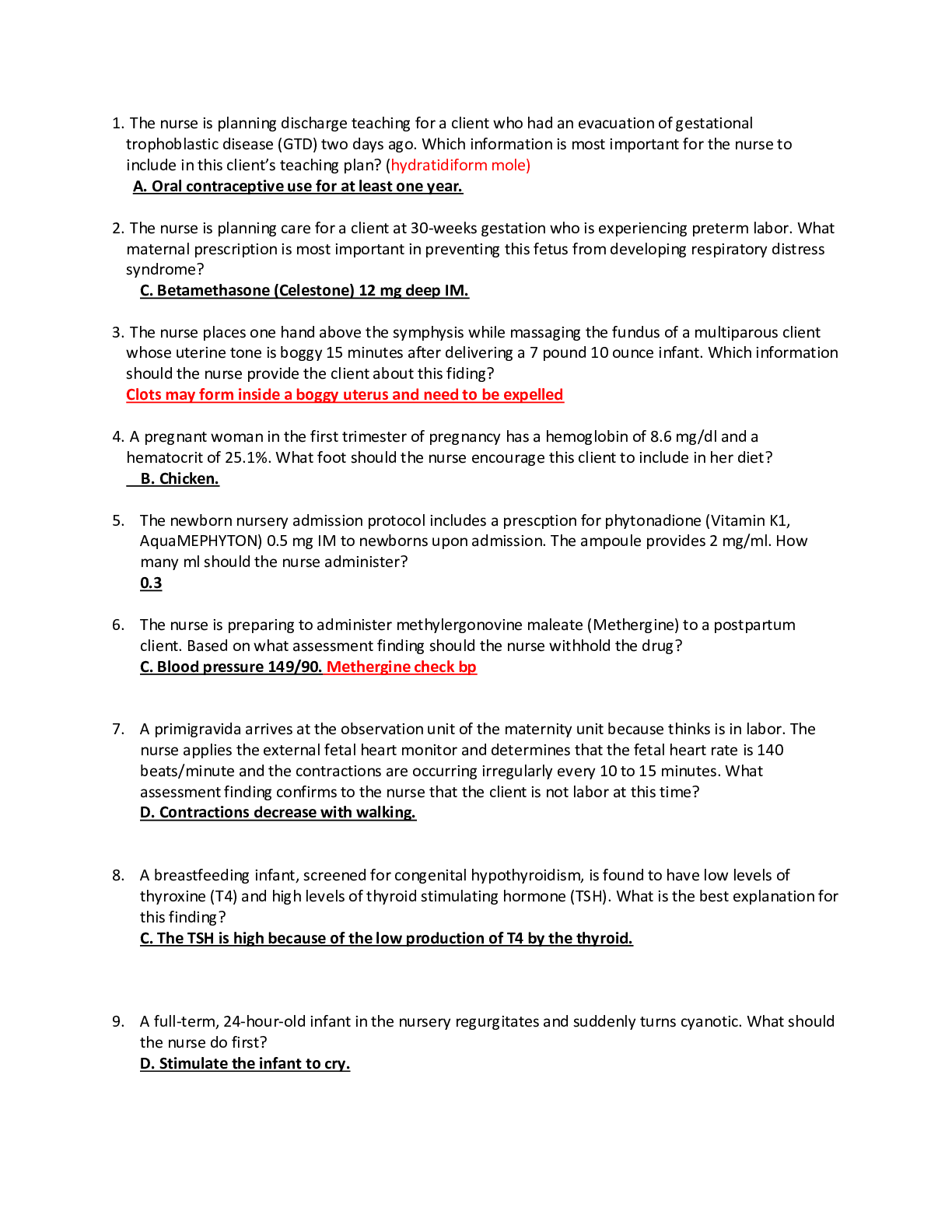
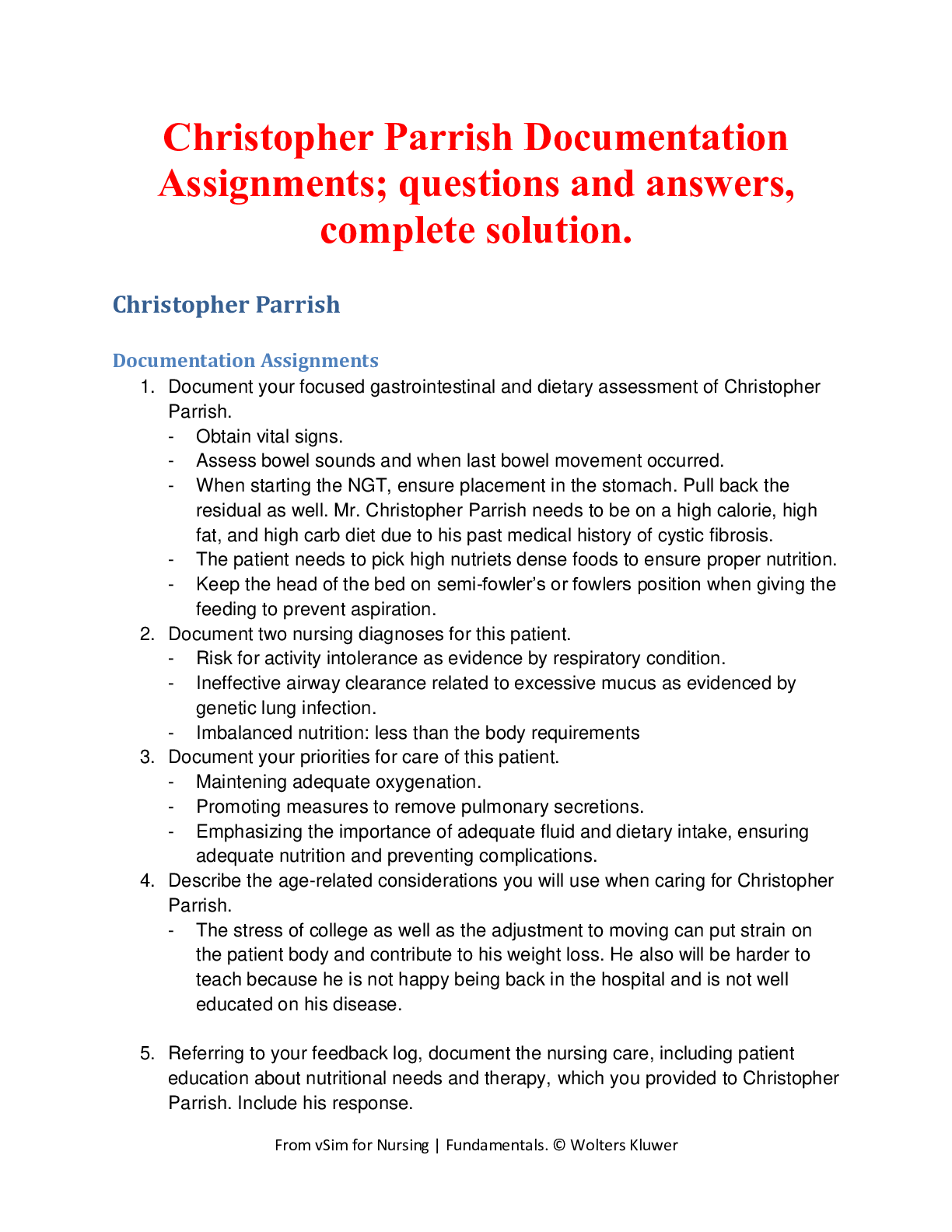
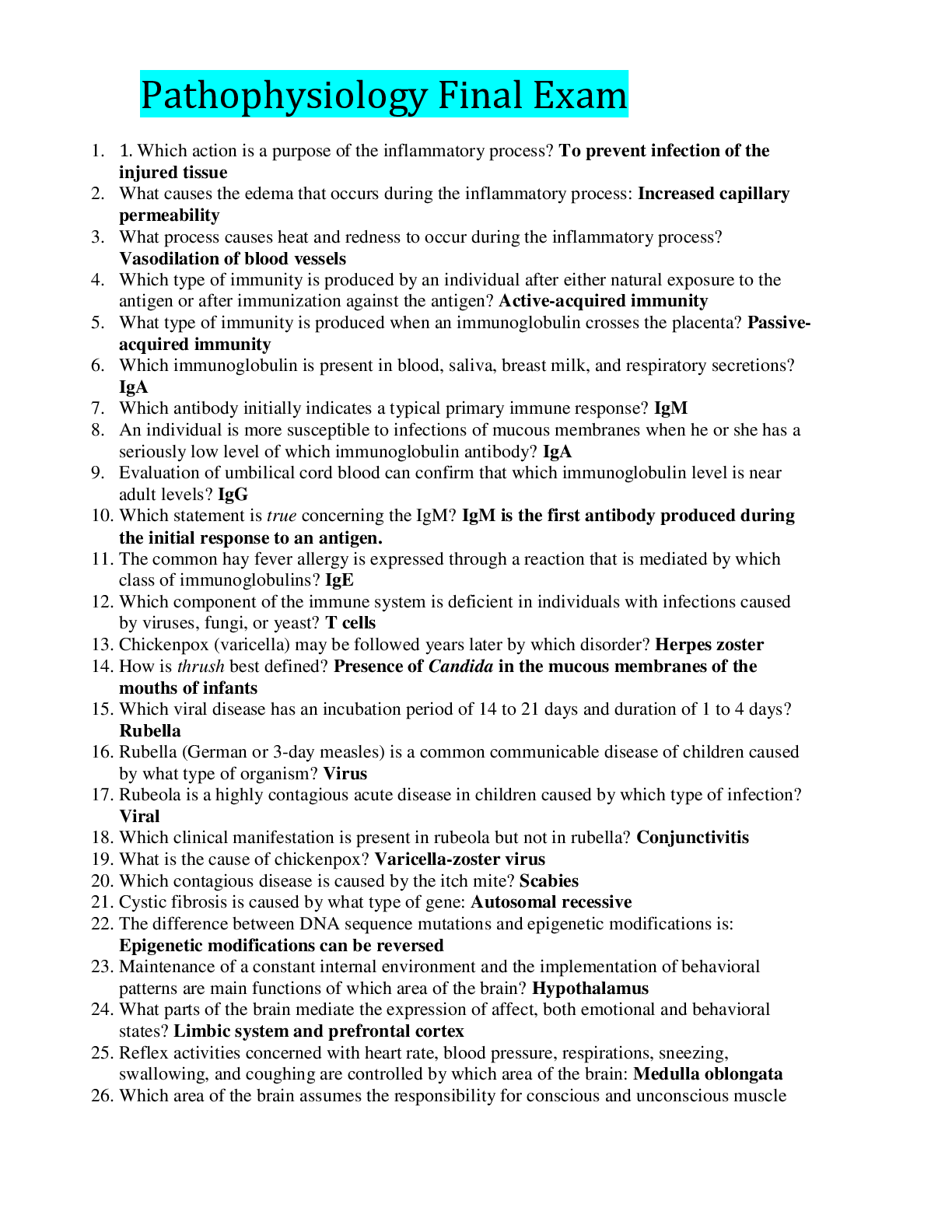
.png)



